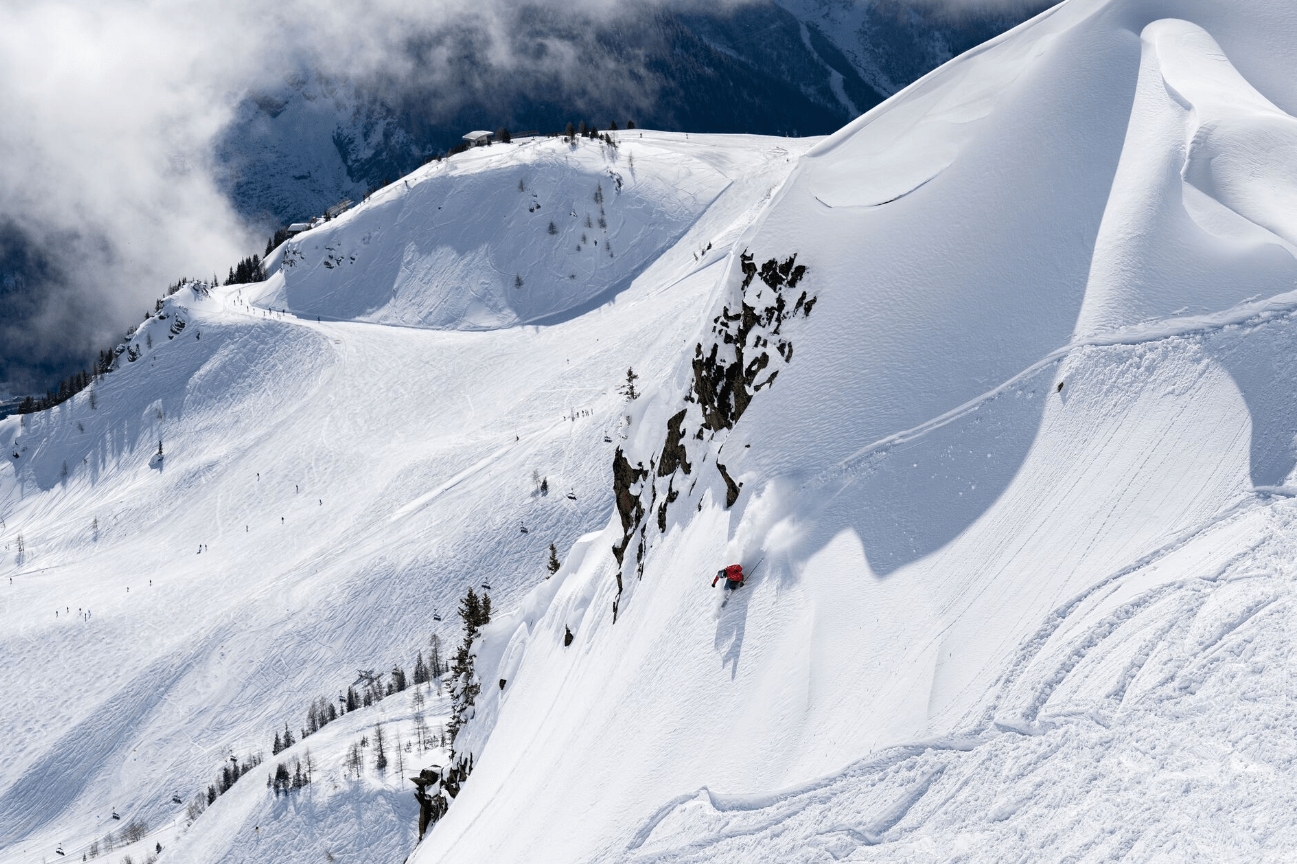The Ski Term Glossary

The Ski.com Dictionary
New to skiing and unfamiliar with all the jargon? Don't worry. We'll get you up to speed. As North America’s largest provider of ski vacation packages, we get a lot of questions about everything related to skiing. Our Mountain Travel Experts have skied and stayed at all of the 120-plus ski resorts we sell worldwide. They really know their stuff when it comes to terrain, ski vacations, ski accommodations and ski resorts, which is why we tapped them to help define some key terms related to skiing. If you have additional questions about any of the ski terms below, don’t hesitate to give one of our knowledgeable Experts a call or start a chat!
A
Alpine skiing: Downhill skiing where the toe and heel of the boot are fixed to the ski.
Après-ski: The nightlife following a day of skiing, e.g. shopping, drinking, listening to live music or relaxing in a hot tub. Learn more about the best resorts for après-ski.
B
Backcountry skiing: Also called off-piste or out-of-bounds, this type of skiing happens in unmarked, unpatrolled areas beyond the boundaries of the resort. Experience, avalanche knowledge and proper equipment is imperative when backcountry skiing.
Base: Average depth of snow on the mountain; also the bottom of the mountain where the lodge is located.
Basket: A round, generally flat, disc located near a ski-pole tip to prevent the pole from sinking too far in the snow.
Big-mountain skiing or snowboarding: The style of skiing or snowboarding seen in ski movies, featuring fast, big turns on long, steep vertical descents and, usually, cliff drops.
Blower: A term for extremely light snow that exists in ample amounts.
Black Runs: In Europe, ski runs are classified by different colors with black indicating expert terrain.
Bowl skiing: Skiing on wide bowl-shaped slopes with or without trees. See Cirque below.
Brain bucket: A helmet.
Bunny slope: The area of the mountain with a gradual decline, perfect for beginner skiers to be taught basic ski techniques. Learn more about the best ski resorts to learn to ski.
C
Carve: The act of digging the ski/snowboard’s edge into packed snow in order to turn.
Catching an edge: When the edge of a ski or snowboard accidentally digs into the snow, usually resulting in a fall or a near fall.
Cat-skiing: Backcountry or off-piste terrain which is accessed via a snowcat.
Chairlift: A type of aerial lift, which consists of a continuously circulating steel cable loop strung between two end terminals and usually over intermediate towers, carrying a series of chairs, typically with skier or snowboarder passengers.
Chondola: A ski resort lift that features a mix of chairlifts and gondola cars.
Chutes: Narrow sections of snow between two rock walls typically skied by expert or advanced skiers or snowboarders.
Cirque: A bowl shape or amphitheater usually sculpted out of the mountain terrain by a glacier.
Cliff-hucking: A move done by only experienced skiers and overly ambitious beginners in which the skier jumps off a cliff.
Cold Smoke: Extremely light powder snow that is typically found in areas of the Northern Rockies and Canadian Rockies.
Corduroy: Named for the ridges in the snow caused by grooming machines, corduroy is another word for groomer or groomed slope.
Corn: Snow characterized by its large corn-kernel-sized granules found during the spring.
Cornice: An overhanging mass of snow at the edge of a ridge or peak.
Couloir: The French word for ‘corridor,’ a couloir is a narrow, long chute that is often the result of previous, glacial calving.
Cross-country skiing: Skiing on flat terrain using self-produced power with no extra help from slopes. There are two recognized cross-country skiing techniques: “skating” and “classic” (or “striding”). Cross-country skiing is more aerobic than alpine skiing and uses lighter weight boots and lighter, narrower skis.
Crud: A type of snow characterized by an uneven surface, usually encompassing some lumps of soft powder-like snow as well as icy or slippery patches.
D
DIN settings: Deutsche Industrie Normen (DIN) is a scale to ensure ski bindings release under the same force at all skiing destinations worldwide.
Downhill: A speed discipline in alpine ski racing, downhill features poles (gates) which are set the maximum amount apart to increase speeds.
Dry slope: Common in England, dry slopes are small ski hills made out of synthetic material that is meant to imitate a snowy surface.
Dump: An unusually large or heavy snowfall.
E
Early season: The beginning of ski season. Typically before the New Year. Learn more about the best resorts for early-season skiing.
Edge: A metal strip found on the bottom sides of skis and snowboards used for carving.
Ego bumps: Small, well-spaced moguls on an intermediate slope that are generally easier to ski than those found on more difficult slopes.
Epic: A day characterized by the large amount of powder or other conditions that make it unforgettable and out of the norm.
F
Fall line: The line a ball would follow if rolled down the slope; the quickest route down the mountain.
Figure eight: Tandem skiers whose tracks when viewed from above give the illusion of the numerical “eight.”
Figure eleven: The tracks left by a skier who makes no turns.
First tracks: When a skier is the first to ski an area of fresh snow before anyone else; also known as “freshies.”
Freeride skiing or snowboarding: see Big-mountain skiing.
Freestyle skiing: A skiing discipline that incorporates aerial acrobatic techniques into downhill skiing.
Funicular: A cable railway in which a pair of tram-like cabs on rails moves along cables and transports skiers up and down a steep slope. Funiculars are more widely found in Europe. Learn more about the world's top funiculars.
Funitel: An aerial cable lift used to transport skiers. Funitels are more widely found in Europe. Learn more about the world's top funitels.
G
Gaper: A skier who does not understand proper on-slope etiquette, ski wear or ski technique.
Giant slalom: An alpine ski racing discipline in which the poles (gates) spaced at a greater distance to each other than Slalom but less than in Super-G.
Gondola: A gondola is an enclosed lift suspended from a cable to transport passengers up and down a mountain. Learn more about the world's top gondolas.
Grass skiing: An all-seasons skiing discipline done on grass with specialized equipment.
Groomed slope: Refers to the slope terrain that has been groomed and is now smooth.
H
Halfpipe: A pipe-shaped snow construction which amateur and competitive skiers and snowboarders perform tricks out of as they descend down the hill.
Hard-packed: A euphemism to describe icy conditions; generally occurs with the lack of new snowfall.
Headwall: A steep cliff, usually the uppermost part of a cirque.
Heli-skiing: A skiing discipline requiring helicopter transportation to the highest slopes and known for providing skiers/boarders with fresh tracks.
Herringbone: A skiing technique named after the marks left by skis when a skier nudges upward through the snow.
I
Indie grab: An industry term for grabbing the skis or snowboard under the boot on the outside edge while executing a jump.
J
Jib[bing]: Any single or combination of tricks on skis or a snowboard, generally done in terrain parks, but not limited to that.
Jump turn: A method of turning direction by jumping with your skis in the air; generally used in steep terrain.
K
Kick turn: An about-face turn while stationary, by lifting one ski and reversing its direction, followed by the other ski.
Kicker: The sharply angled end of a jump, allowing a skier or boarder to gain significant height.
L
Liftie: A lift operator.
M
Magic carpet: A type of conveyor or surface lift often found in beginner learning areas for its ease of use.
Mashed potatoes: Wet, heavy snow.
Milk run: The first run of the day.
Moguls: Mounds of snow, also known as bumps.
N
NASTAR: Citizen racing program with courses at many mountains allowing anyone to participate and to handicap themselves against world-class racing times.
Never-ever: Someone who has never skied and signs up for a first-time ski lesson.
Nordic skiing: See Cross-country skiing.
O
Out-of-bounds: Terrain outside the boundary of the ski area with no avalanche control or ski patrol; many times these areas are illegal to ski.
On-piste: "Piste" is the French word for trail or run. Therefore, "on-piste" would mean on a trail or run, typically a groomed one.
Off-piste: "Off-piste" means in uncontrolled terrain, i.e. in sidecountry or backcountry areas.
P
Pillows: The soft tops of moguls after a fresh powder dump.
Pizza: Performed by slowly snowplowing down a slope; generally used by ski instructors when teaching young children.
Pond skimming: A silly spring-skiing past-time at ski resorts in which skiers don costumes and try their best to skim across an icy pond. Check out our guide to pond skimming.
Powder: The “ideal” ski condition that occurs after a fresh dump of snow.
Pre-release: Denotes the situation when skis unhinge earlier than anticipated.
Q
Quad: A chairlift carrying four people.
Quiver: A collection of ski types. For example, a full quiver of skis would include an all-mountain pair, a powder pair and a frontside pair. A one-quiver ski means it’s a very versatile ski.
R
Red Runs: In Europe, ski runs are classified by different colors with red indicating intermediate slopes.
Rockered skis: Introduced in 2002 when the late Shane McConkey brought the Volant Spatula to market. The "rockered" shape of the ski mimics the attributes of a water ski, enabling a skier tp float over a surface with minimized risk of snagging an edge. Learn more about rockered ski technology.
Roller skiing: An all-seasons skiing discipline generally performed by cross-country skiers as training in the off-season.
Rope tow: The lift more commonly found on bunny hills and some green-rated slopes, but also found reaching difficult terrain. Also known as a surface lift because the skier/snowboarder keeps their skis/snowboard on the snow and holds onto a rope which pulls them up the hill.
Rail slide: A technique performed by sliding skis or a board across a metal or wooden rail, generally done in terrain parks.
S
Shaped skis: Relatively new and improved skis characterized by some form of an hourglass shape, and designed for easier turning.
Schuss: To ski down the slope without turning.
Six-pack: Six seated chairlift.
Ski in ski out: Lodging on or near the slopes allowing skiers to ski in and out of their accommodations. *Definitions vary by resort and should be carefully checked by a Ski.com Mountain Vacation Specialist.
Skijoring: The winter recreation activity of being pulled over snow by a dog, horse or a motor vehicle.
Ski lift: See Chairlift.
Ski touring: A form of skiing where both uphill and downhill travel is possible without needing to remove skis. Typically, ski touring is done in the Backcountry or off-piste, and skis, bindings and boots allow for free movement of the heel to enable a walking pace.
Skins: Used in Ski touring and Uphilling, adhesive backed strips of fabric stick to your skis or splitboard and have tiny rearward facing directional hairs to let you slide forward without slipping back.
Slalom: An alpine ski racing discipline in which the poles (gates) spaced more closely than those in Giant Slalom, Super G and Downhill, necessitating quicker and shorter turns.
Slush: Melted, wet snow prevalent during spring skiing.
Slopeside: See Ski in ski out.
Slopestyle: A freestyle discipline in which athletes’ ski or snowboard down a course with a variety of obstacles including rails, jumps and other terrain park features.
Snowboarding: Skiing on one “ski” which is wider and shorter, with both feet fixed in a position similar to surfing or skateboarding.
Snow plough: A braking maneuver whereby skiers move their ski tips to form a triangular shape also referred to as a wedge or pizza.
Snorkeling: When powder runs up the body and blurs a skier’s vision. This is what powder skiers live for.
Stem christie: A basic turn begun with a wedge and completed by skidding on both uphill ski edges until your skis are parallel.
Super G: Like Downhill alpine racing, Super G is a"speed" event, in contrast to the technical events Giant Slalom and Slalom. The poles (gates) are closer together than Downhill, however.
T
T-Bar: See ropetow
Telemark skiing: A skiing discipline where the heel of the ski is not fixed and requiring a different technique from alpine skiing.
Terrain park: A maintained area with a variety of jumps, half-pipes, rails and other obstacles.
Tram: Also known as aerial tramway or cable car, a tram is an aerial lift that transports skiers up the mountain in a contained cab on a cable. Learn about the world's top trams.
Traversing: Moving horizontally across a slope so as to lose or gain a minimal amount of elevation.
U
Unweighting: Taking weight off the ski, usually prior to a turn.
Uphilling: Similar to Ski touring, but not specific to a Backcountry excursion. Many “uphillers” will “Skin” up the ski resort for exercise.
V
Vertical drop: The vertical distance from the top to the bottom of the mountain or slope. Learn more about the longest, lift-served vertical drops at North American ski resorts.
W
Whiteout: Limited visibility due to snow, fog or flat light.
White room: See Snorkeling.
Wind Buff: A snow condition that is created by an abundance of wind blowing loose snow onto a leeward aspect.
World Cup: International races for all disciplines including alpine, cross-country, ski jumping, freestyle skiing and snowboarding and more.
X
X-C: An abbreviation of Cross-country skiing.
Y
[Skiing] Yard sale: A major fall resulting in the skier/snowboarder’s clothes or equipment being strewn all over the hill – mimicking a yard sale.
Z
Zig zag: Traversing across a slope in a “z” formation.A
Ski.com, Trusted by Thousands of Travelers Since 1971
Emma is great!
Emma is great! Her help in booking my trip this year again has made this so easy. Our trip last year to Jackson Hole was amazing. Can't wait to see Breckenridge this year. Thanks Emma!
Ann is the best!
Ann is the Best! Always quick to respond and with great recommendations.
Exactly what I needed!
Working with Cody Jenick to customize my group's trip was exactly what I needed. Honest advice drawn from experience, understanding of what we wanted to get out of the trip, and patience with my decision-making. There is no doubt I will be using his services to book my future ski trips!!



